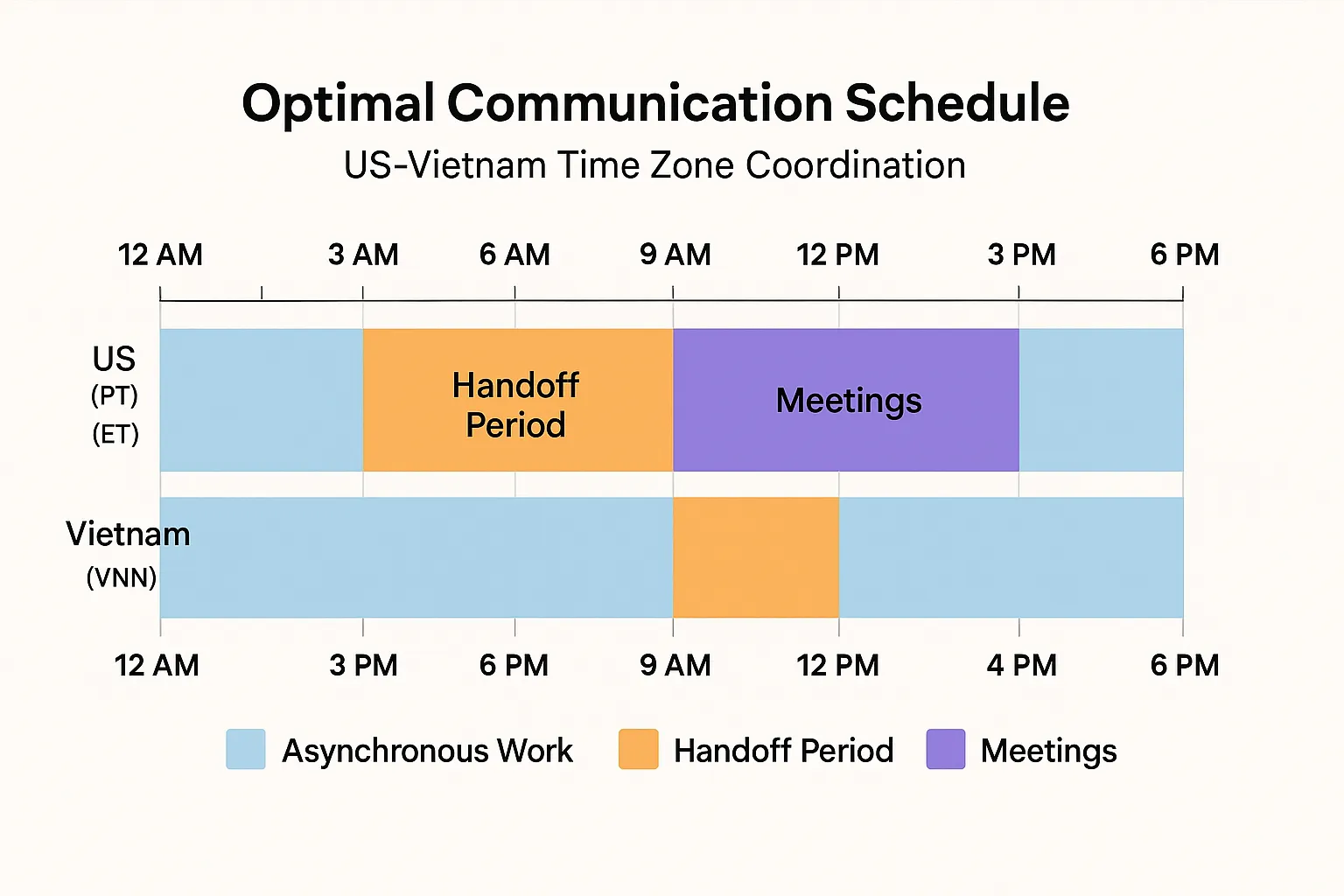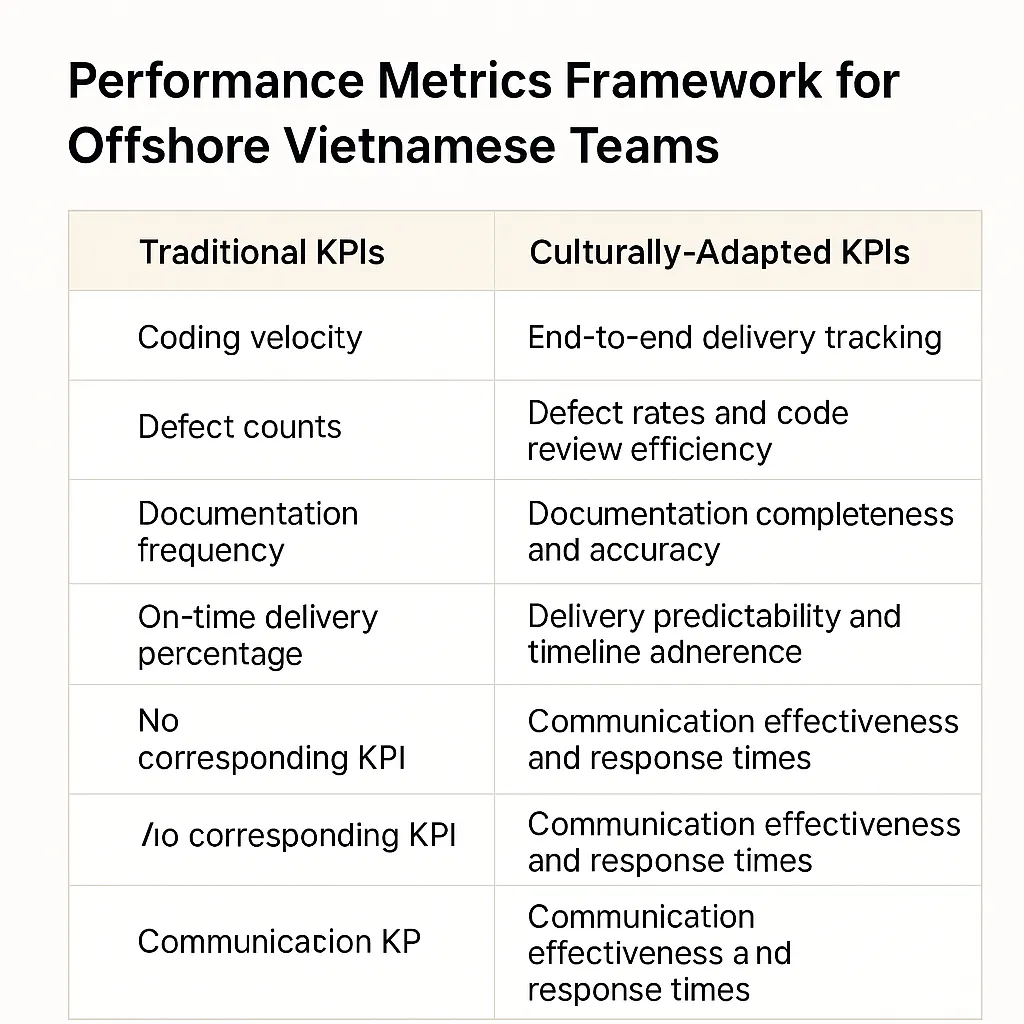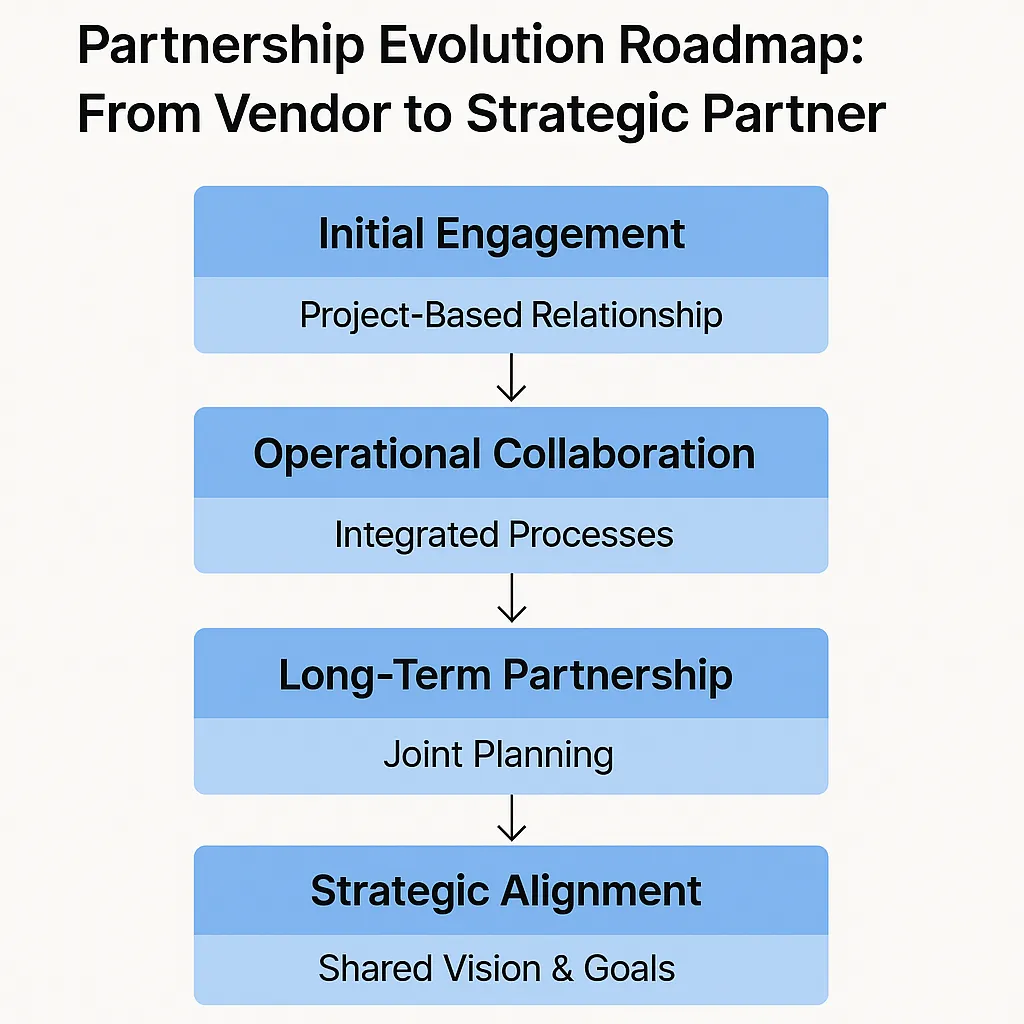Managing offshore teams in Vietnam isn’t rocket science—but 73% of companies still struggle with it. The main culprit? Communication breakdowns that turn promising partnerships into expensive headaches.
Vietnamese development teams offer incredible technical talent at competitive rates, but success requires more than just good code. You need structured communication protocols, cultural awareness, and the right tools to bridge the 12-hour time difference effectively.
This guide gives you actionable strategies based on real data from Vietnam’s rapidly growing IT workforce of 500,000+ professionals and proven frameworks from companies managing successful offshore partnerships. You’ll learn exactly how to set up communication systems, manage cultural differences, and build long-term relationships that actually work.

Fig.1 Optimal Communication Schedule: US–Vietnam Time Zone Coordination.
Successfully managing Vietnamese offshore teams requires structured daily standups, asynchronous communication protocols with 4-hour response SLAs, and cultural investment.
Companies that allocate 15-20% of project time to relationship building see 22% higher retention rates and faster delivery.
Why Vietnam Is Your Best Bet for Offshore Software Development
Vietnam stands as one of Asia’s fastest-growing offshore development destinations, employing over 500,000 IT professionals with a 15-25% cost advantage over traditional markets like India and the Philippines. The country’s IT sector is growing at an annual rate of 8-16%, making it a strategic choice for long-term partnerships.
Here’s what makes Vietnam particularly attractive for offshore development:
- Strong educational foundation: Vietnam produces approximately 55,000-60,000 IT graduates annually
- Competitive salary ranges: Software developers earn $1,100-$3,000 monthly, offering significant cost savings
- High English proficiency: A majority of Vietnamese IT professionals possess strong English skills, facilitating international collaboration
- Modern technical skills: Vietnamese developers excel in current frameworks and technologies, particularly in web development and mobile applications
The infrastructure backbone supports seamless global operations. Major development hubs in Ho Chi Minh City, Hanoi, and Da Nang offer reliable internet connectivity enabling global operations, while strategic time zone positioning provides productive overlap with both US and European teams.
“Vietnam’s tech workforce is not only rapidly expanding but is also highly-skilled in modern software frameworks, enabling the country to move up the value chain in global IT services,” notes Nguyen Duc Thanh, Chairman of Vietnam Software Association.
A real-world example: SmartDev leveraged Vietnam’s robust developer pool in Da Nang and Hanoi to achieve substantial growth while supporting 300+ global clients across diverse industries.
The cultural work dynamics add another competitive advantage. Vietnamese teams prioritize relationship-building and long-term partnerships over transactional engagements, creating stability for extended projects. However, hierarchical communication structures require clear escalation paths—something we’ll address throughout this guide.
How to Structure Daily Communication for Maximum Efficiency
Effective daily communication starts with fixed standup times accommodating both time zones, typically scheduled at 9 AM Vietnam time (7 PM PST the previous day). This timing captures the tail end of US business hours while starting Vietnam’s productive day.
Essential Communication Protocols
67% of global organizations have moved collaboration to the cloud, making asynchronous communication standards critical. Here’s your framework:
Response Time Standards:
- 4-hour maximum response during business hours
- Emergency escalation paths for critical issues
- Clear definitions of what constitutes “urgent” vs. “important”
Documentation Requirements:
- All technical decisions documented within 24 hours
- Meeting summaries sent within 2 hours of conclusion
- User story acceptance criteria including business context
Meeting Structure:
- Daily standups: 15 minutes maximum, agenda-driven
- Weekly retrospectives focusing on communication effectiveness
- Monthly cultural alignment sessions
“Daily standups and setting asynchronous response expectations are crucial for distributed teams; response time SLAs under four hours should be standard to align on tasks,” explains Alistair Copeland, CEO of SmartDev.
Managing Time Zone Realities
The 12-hour time difference between Vietnam and the US East Coast actually becomes an advantage when properly managed. Vietnamese teams can review code and provide feedback while your US team sleeps, creating a “follow the sun” development cycle.
Best practices for time zone management:
- Rotate meeting sacrifice fairly: Don’t always make the same team join at inconvenient hours
- Record critical meetings: 85% of effective offshore Agile teams mandate meeting recordings for asynchronous review
- Create handoff documentation: Clear status updates at end-of-day for seamless transitions
- Establish overlap hours: Identify 2-3 hours of natural overlap for real-time collaboration

FIg.2 Optimal Communication Schedule: US-Vietnam Time Zone Coordination
Your Technology Stack for Seamless Cross-Border Collaboration
Your project management platform forms the collaboration foundation. 90% of new enterprise apps launched in 2024 featured AI or automation, while Jira and Monday.com lead the market for managing distributed software projects.
Core Platform Requirements
Choose platforms supporting both real-time collaboration and asynchronous updates:
Project Management:
- Automated progress tracking and notifications
- Time zone-aware scheduling and deadlines
- Integration with development tools and workflows
- Clear visibility into task status and blockers
Communication Tools:
- 72% of distributed software teams use Slack or Microsoft Teams
- Organized channels by project, urgency, and domain
- 97% integrate video recording/transcription for critical meetings
- Smart notification filtering to respect time zones
Development Environment:
- Cloud development environments like GitHub Codespaces and GitPod are growing rapidly, with the CDE market projected to reach $70 billion by 2033
- Eliminates “works on my machine” problems across continents
- Consistent development environments using Docker or VMs
- Automated testing and deployment pipelines
Documentation and Knowledge Management
Documentation becomes your safety net across time zones. Establish centralized documentation using Confluence, Notion, or GitBook with these features:
- Version control and commenting capabilities
- Searchable technical decision records (TDRs)
- Visual aids and screen recordings for complex explanations
- Automated API documentation generation
Case Study Success: Organizations using centralized knowledge bases like Notion and Confluence achieve 30% onboarding time reduction through AI-powered analytics and self-service documentation, while eliminating up to 40% of redundant questions through comprehensive SOPs, internal wikis, and role-specific training materials..
“A robust project management platform—Jira or Linear—paired with versioned documentation and integrated code review tools, is non-negotiable for truly distributed software collaboration,” states Luan Nguyen, General Director at SmartDev.
Security and Compliance Considerations
78% of organizations deploying offshore teams use VPNs with two-factor authentication and comply with major frameworks like SOC 2 and GDPR.
Security essentials for Vietnamese offshore teams:
- VPN access with multi-factor authentication
- Data handling protocols compliant with GDPR, SOC 2
- Security incident response procedures with clear escalation
- Application performance monitoring for system health
Building Cultural Bridges That Actually Work
Effective offshore teams allocate 15-20% of project kickoff efforts to cultural alignment, and organizations that invest in relationship building report 22% higher offshore team retention rates. This isn’t just nice-to-have—it’s ROI-driven strategy.
Communication Style Adaptations
Vietnamese teams often prefer indirect communication, so adapt your feedback approach:
Instead of asking: “Is this deadline realistic?”
Try: “What challenges do you foresee with this timeline, and how can we address them together?”
Key Cultural Considerations:
- Allow additional processing time for complex decisions
- Provide positive reinforcement frequently
- Start with smaller deliverables before expanding scope
- Create multiple pathways for raising concerns without loss of face
Relationship Building Strategies
- Monthly virtual coffee sessions separate from project discussions
- Cultural exchange – recognize Vietnamese holidays while sharing your traditions
- Public achievement celebration within your organization
- Gradual responsibility transfer with regular feedback sessions
Real Results: Global development teams implementing monthly cross-cultural bonding activities like structured coffee chats report 42% greater comfort reaching out to colleagues across locations within three months, with cross-team collaboration increasing by 175% and critical issue resolution time declining by 48% within one year..
“Investing in relationship-building upfront and recognizing cultural holidays fosters trust, reduces attrition, and increases productivity over the project lifespan,” explains Trang Hoang, Head of HR at SmartDev.
Understanding Vietnamese Work Culture
Vietnamese culture emphasizes relationship harmony and consensus-driven decision-making. Rather than prioritizing speed, Vietnamese business leaders typically consult widely and seek broad team alignment, making the process appear slower but ensuring thorough risk assessment and lasting buy-in. This approach is deeply rooted in values of collectivism and harmony, and remains a defining feature of successful teams in Vietnam.
Working effectively with Vietnamese teams:
- Respect hierarchical structures while encouraging input
- Allow time for internal team discussions before decisions
- Provide clear context for business decisions, not just technical requirements
- Celebrate team achievements publicly to reinforce partnership value
Performance Management That Actually Motivates Remote Vietnamese Teams
Teams using SMART-aligned KPIs adapted for offshore schedules experience 18% faster project delivery. The key word is “adapted”—standard performance metrics often fail across time zones and cultural contexts.
Effective KPIs for Offshore Teams
Instead of measuring pure coding velocity, track end-to-end delivery:
Quality Metrics:
- Defect rates and code review efficiency
- Documentation completeness and accuracy
- Delivery predictability and timeline adherence
- Communication effectiveness and response times
Team Health Indicators:
- Response time to inquiries (target: <4 hours during business hours)
- Meeting effectiveness scores
- Cultural integration feedback
- Knowledge transfer quality
Feedback and Development Systems
Bi-weekly 1:1 sessions reduce team member churn by 27% in Vietnam-based teams. Structure these sessions to address concerns proactively:
- Individual check-ins with key team members
- Anonymous feedback channels for honest upward communication
- Quarterly team health surveys measuring communication effectiveness
- Monthly retrospectives focusing on cross-cultural improvements
“Frequent performance feedback and clear goal-setting are essential for Vietnamese developers, especially given hierarchical local business culture,” notes Nguyen Le, COO at SmartDev.
Success Story: Organizations implementing anonymous feedback channels and quarterly pulse surveys have documented remarkable results: a mid-sized tech firm (Tech Innovate) achieved a 32% boost in team satisfaction within six months, while anonymous feedback adoption increased overall engagement by 35%.

Fig.3 Performance Metrics Framework for Offshore Vietnamese Teams
Ready to strengthen communication and collaboration with your offshore development team in Vietnam?
Explore proven communication frameworks, collaboration rituals, and leadership strategies that help global teams build trust, prevent delays, and deliver consistently.
Learn how to apply Vietnam-specific cultural insights, communication rhythms, and team-governance models to maximise productivity and long-term partnership success.
Explore the Vietnam Offshore Team Communication PlaybookSolutions for the 5 Most Common Management Challenges
Challenge 1: Time Zone Coordination Bottlenecks
The Problem: 78% of distributed software projects cite time zone management as a primary challenge.
The Solution: Implement “follow the sun” development with structured handoffs:
- Asynchronous code reviews that maintain velocity without scheduling conflicts
- Clear handoff protocols with written documentation
- Rotating meeting times to share the burden fairly
- Recorded critical meetings for team members in non-optimal zones
Results: A US fintech using SmartDev’s protocol reduced delivery bottlenecks by 30% through structured code review and scheduled overlap meetings.
Challenge 2: Language and Communication Barriers
The Problem: 51% of distributed teams struggle with misunderstandings despite hiring English speakers.
The Solution: Systematic communication reinforcement:
- Written summaries of all verbal communications within 2 hours
- Visual aids and screen recordings to supplement explanations
- Technical glossaries specific to your project domain
- Standardized templates for common communications
Results: Teams including visual documentation achieve 35% faster onboarding for new team members.
Challenge 3: Quality Control Consistency
The Problem: Maintaining consistent standards across different cultural approaches to work.
The Solution: Automated enforcement over cultural adaptation:
- Continuous integration pipelines enforcing quality standards
- Detailed coding standards with technology-specific examples
- Pair programming sessions during overlap hours for knowledge transfer
- Automated testing requirements as part of definition of done
Challenge 4: Project Visibility and Status Updates
The Problem: Lack of real-time visibility into progress across time zones.
The Solution: Systematic transparency tools:
- Automated deployment pipelines with status visibility
- Daily progress dashboards updated asynchronously
- Standardized status reporting with consistent formats
- Escalation protocols for blocked or delayed items
Challenge 5: Team Cohesion and Culture Alignment
The Problem: Remote teams feeling disconnected from company culture and goals.
The Solution: Intentional culture building:
- Regular virtual team building activities
- Cross-training programs between onshore and offshore teams
- Joint innovation initiatives allowing strategic contribution
- Clear career development paths within the partnership
“Deliberate asynchronous communication, paired with strong handoff documentation, is the backbone of seamless time zone collaboration,” emphasizes Alistair Copeland, CEO of SmartDev.
Technology Integration Best Practices for Global Development Teams
Over 85% of leading tech companies use CI/CD pipelines for product delivery, with teams reporting 46x more frequent deployments and 2.5x faster software delivery—making automated deployment pipelines essential for offshore teams managing cross-continental integration demands.
Distributed teams need automated consistency more than co-located teams need manual flexibility.
Development Workflow Standards
Version Control and Branching:
- Implement GitFlow or GitHub Flow with clear strategies
- Automated deployment pipelines with status visibility
- Mandatory code review requirements before merges
- 92% of IT professionals use Docker or VM-based standardization
Environment Management:
- Standardized development environments using Docker/VMs
- Consistent deployment processes across all environments
- Automated testing requirements integrated into CI/CD
- Configuration management for environment consistency
Case Study: SmartDev’s shift to GitFlow and Docker reduced deployment errors by 44% and cut environment setup for new developers to under one day.
Security and Compliance Framework
Security management requires extra attention with offshore teams:
Access Control:
- VPN access with multi-factor authentication
- Role-based access controls for code repositories
- Regular security training and awareness programs
- Incident response procedures with clear escalation
Compliance Management:
- Data handling protocols for GDPR, SOC 2 compliance
- Regular security audits and assessments
- Documentation of security procedures and training
- Backup and disaster recovery procedures
“Standardized workflows with automated deployment and consistent environments are core to reliable multi-location software delivery,” states Nguyen Le, COO at SmartDev.
Monitoring and Analytics
Deploy application performance monitoring tools providing real-time visibility:
- System health monitoring with automated alerting
- Team productivity analytics for process optimization
- Collaboration effectiveness metrics tracking communication quality
- Performance benchmarking against industry standards
Building Long-term Partnership Success with Vietnamese Teams
Offshore teams with internal leadership programs and career pathing report 30%-40% higher talent retention over three years. Long-term success requires treating Vietnamese teams as partners, not resources.
Leadership Development and Career Growth
Developing Local Leadership:
- Identify and develop team leaders within the Vietnamese team
- Create decision-making authority for local technical choices
- Provide leadership training and advancement opportunities
- Establish mentorship programs with senior onshore developers
Career Advancement Paths:
- Clear progression opportunities within the partnership
- Cross-training between different technologies and domains
- Conference and training budget allocation
- Recognition and promotion pathways
“Developing dedicated local leaders and investing in career development fosters loyalty and drastically reduces retention risk in offshore models,” explains Luan Nguyen, General Director at SmartDev.
Knowledge Transfer and Continuity
Companies with structured knowledge transfer playbooks achieve 42% faster onboarding, 25% training cost reduction, and 82% higher retention rates, with offshore teams reaching full productivity 2x faster.
Knowledge Management Systems:
- Video documentation libraries covering technical and business context
- Comprehensive onboarding programs for new team members
- Cross-training ensuring knowledge redundancy
- Technical decision records documenting architecture choices
Continuity Planning:
- Backup personnel for key roles and responsibilities
- Knowledge sharing sessions between team members
- Documentation of critical processes and procedures
- Regular knowledge transfer assessments
Strategic Partnership Evolution
Quarterly Business Reviews:
- Partnership effectiveness beyond project delivery
- Strategic alignment and goal setting
- Process improvement recommendations
- Relationship health assessment
Innovation Collaboration:
- Joint product development initiatives
- Technology research and development projects
- Strategic input on product roadmap and architecture
- Intellectual property sharing agreements
Success Story: SmartDev’s quarterly business review program with key clients resulted in 92% client retention rate and numerous strategic co-development initiatives.

Fig.4 Partnership Evolution Roadmap: From Vendor to Strategic Partner
Ready to Transform Your Offshore Development Partnership?
The transition from vendor management to strategic partnership requires intentional investment in people, processes, and relationships. Companies that make this transition see better retention, higher quality delivery, and more innovative solutions.
The key insights for managing Vietnamese development teams successfully:
- Structure beats spontaneity – Clear communication protocols and workflows matter more than perfect cultural understanding
- Invest in relationships early – The 15-20% upfront investment in cultural alignment pays dividends throughout the partnership
- Automate what you can – Let technology handle routine coordination while humans focus on strategic work
- Adapt your management style – Vietnamese teams thrive with clear expectations, positive reinforcement, and gradual trust building
- Think partnership, not outsourcing – Long-term success comes from treating offshore teams as strategic partners
Ready to implement these strategies with your Vietnamese development team? SmartDev’s offshore development guide provides detailed frameworks and real-world examples from 300+ successful client partnerships.
Want to explore how these proven practices can work for your specific project? Contact SmartDev’s talent solutions team to discuss your requirements with experts who’ve built successful US-Vietnam development partnerships across industries from fintech to healthcare to e-commerce.
Visit SmartDev.com to learn more about building world-class software with Vietnamese development teams that deliver exceptional results.








